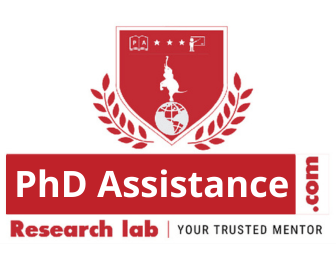Data Analysis Sample Work
Total Quality Management (TQM) in Non-Governmental Organizations (NGO) In India
Info: 2055 words Sample Textual & Content Analysis
Published: 10th JAN 2023
Tagged: Business & Management
Introduction
The study's primary goal is to define Total Quality Management (TQM) in non-governmental organizations (NGOs). To assess Total Quality Management (TQM) in Non-Governmental Organizations (NGOs), the researcher sent the respondents a semi-structured questionnaire. The same research was done with a sample size of 10. The results of the qualitative thematic analysis conducted on the obtained data are shown below in this chapter. The data were first entered in text format and exported into the NVIVO programme. It also details the organization in terms of employee commitment, ongoing improvement, competitor benchmarking, enhancing employee skill sets, top Management communicating with all employees, client focus, customer satisfaction, and how frequently employees engage in activities related to quality. It also discusses business continuity models, process improvement initiatives, real management issues, and the advantages of comprehensive quality management.
Your company's approach to its employees
Respondents were asked to share their thoughts about their company's approaches towards the employees. The findings showed that the organization thoughts their employees as a backbone, as illustrated with the following excerpts, "Most of the Organization concerned for the best of the employees, as they are the backbone of the organization (Resp 1), and it would be committed in terms of carrying out certain duties like caretaking etc. (Resp 2,9), and be a moral support to employees regarding their issues (Resp 3), even the employees also satisfied and give their best in whatever they do. They even care about the welfare of the employees (Resp 4,10) and give proper training in required skills, standardized salary, and CSR activities (Resp 5). They also always try to look at the employee's perspective for any new project, any new implementation (Resp 6), involve employees in our decision-making to seek different perceptions, to take 3rd person opinion (Resp 7,8) and the employees are very loyal and committed to our mission on vision."
Table 4.1 Frequency of organization in terms of employees' dedication
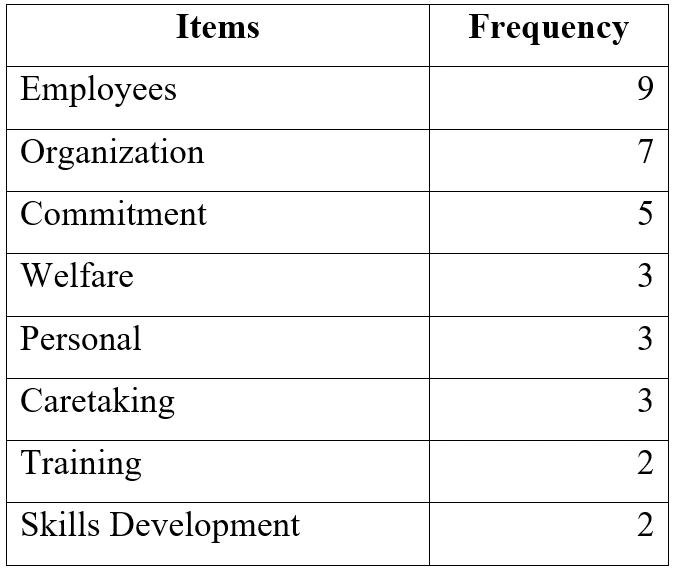
Participation of the organization in enhancing employees' talents
Respondents were asked to share their thoughts about how the organization enhances employees' talents. The findings showed that each organization provides the necessary training for the employees to improve their skill sets, as shown by the following excerpts, "Every organization provides necessary training and evaluation at regular intervals to improve the skill of the employees (Resp 1,8). They also conduct skill development programmes by having sessions from other known institutions (Resp 2,7). In addition, they train employees regarding skills required for their job (Resp 3). To improve the skills, we have regular training and development, appraisals, and reviews on performance (Resp 4, 5), motivate the employees and have certified training as per specialized domain (Resp 6,9). In addition, they also regularly conduct training programs in the form of skill improvement workshops (Resp 10) to improve the employees' talents."
Table 4.2 Frequency of organizations take steps to enhance employee skill levels
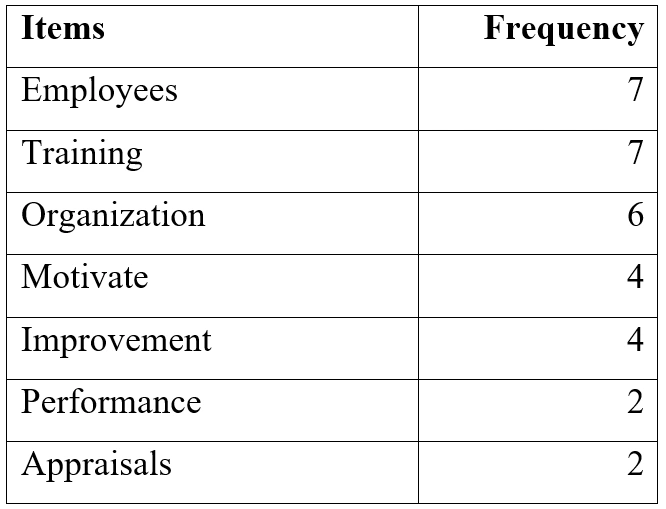
Higher Management interact with every employee
Respondents were asked to share their thoughts about the higher Management interaction with every employee. The findings showed that higher Management would quickly contact the employees, as demonstrated by the following excerpts, "Most of them would communicate with our employees through memos, e-mails etc. (Resp 1,3). The top Management mostly communicates directly with the employees, and sometimes they get to know the happening through different subordinates (Resp 2, 5). There is a free flow of communication within the organization, and Superiors are always available (Resp 4, 7). In some organizations, Centralized and Rigid communication patterns were followed (Resp 6); Management set up timely town hall meetings to provide any new business updates, new initiatives, a business performance so far. Apart from this, if Management communicates to the manager or team lead for any specific business unit, Management is very much approachable to the employees (Resp 8,10). Finally, some followed top management's developed open-door policy system (Resp 9). So, they are easily accessible to the lower-level employers."
Table 4.3 Frequency for Higher Management interact with every employee
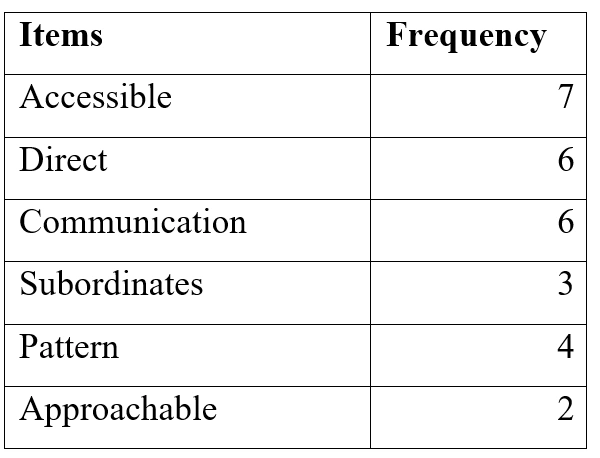
Employees engaged in quality-related organizational activities
Respondents were asked to share their thoughts about quality-related organizational activities. The findings showed that goal to empower persons and families with disabilities, as shown with the following excerpts, "Most of the organization worked to empower their plan (Resp 1), and they ensured that human rights through community-based rehabilitation and inclusive education (Resp 2). Some organizations set strategies based on customer expectations to stimulate customer satisfaction (Resp 3). Some NGOs were concerned with teaching underprivileged students (Resp 4,6). Happiness cannot be measured but can only be seen in the students' results. If there are any unsatisfactory results, they give us training and allow job rotation so that we can handle another set of students and subjects with which we are comfortable (Resp 5,8). Also, organize many programs and initiatives to satisfy customers (Resp 7), and employees are often involved in quality-related activities (Resp 9). Constant quality monitoring, correction of quality deviations, and application of such tactics in quality-related tasks (Resp 10) were regulated to adopt strategies for consumer satisfaction.
Table 4.4 Frequency for Employees engaged in quality-related organizational activities
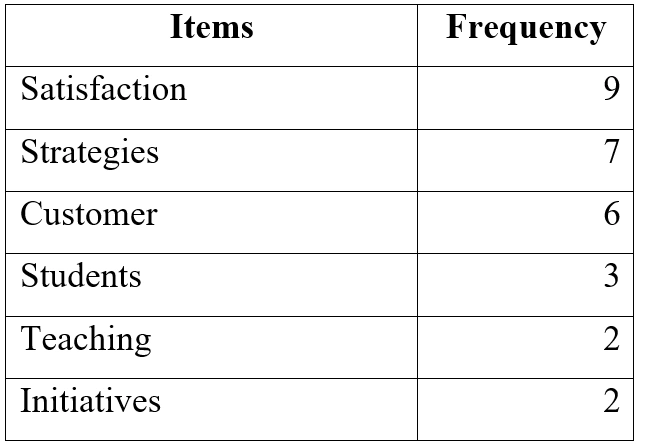
Business continuity model
Respondents were asked to share their thoughts about their NGO's business continuity model. The findings showed that most of them follow the preventive model, as illustrated by the following excerpts, "The appropriate numbers of employees and volunteers to be consistent in our work throughout the year, in any situation (Resp 1), and follow the preventative business continuity model (Resp 2,9). Identifying the threats at an early stage is one of the strategies and helps maintain the business's continuity (Resp 3,8). Most NGOs are on the profitable model to financially support the students in our orphanage (Resp 4,6). They provide them with the best quality education, food (Resp 5,7), and other requirements. They support them until they can stand on their feet (Resp 10) and don't need any financial support."
Table 4.5 Frequency of Business continuity model
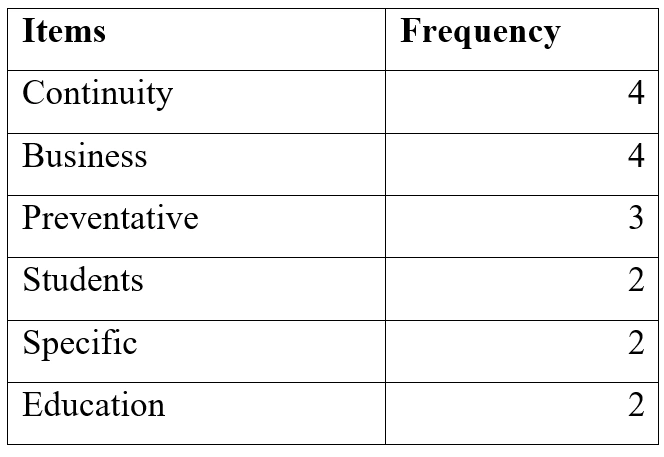
Process improvement initiatives your company
Respondents were asked to share their thoughts about the companies' processes to initiate improvement. The findings showed that they were given only limited time to finish the task, as demonstrated by the following excerpts, "Most of them try to make our work environment eco-friendly, which is not only good for the disabled people but is also safe for the employees and numerous volunteers from localities and different colleges (Resp 1, 9). They also focused on reducing cost, not by minimizing the necessities, but by being more efficient (Resp 2). The organization controls all processes; hence improvements are made, and processes are carried on easily (Resp 3). Some give less time for process improvement (Resp 4), and limited time is given to finish a task to employees so that they finish it fast and improve the process (Resp 5). Then the process improvement is related to the employee's skills as people-oriented and not process-oriented (Resp 6). All kinds of training and assistance are given to the employees (Resp 7). They arranged more process-oriented goals, revised the activities often (Resp 8, 10), trained the employees for the betterment of activities, and adopted new technologies to process their improvement."
Table 4.6 Frequency for process improvement initiatives your company
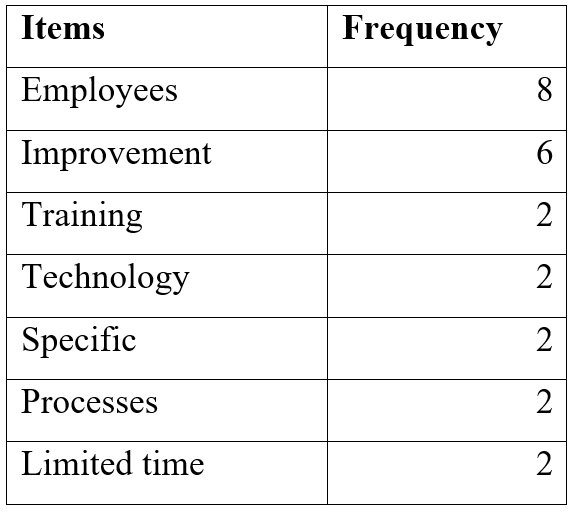
Issues faced with 'Total Quality Management
Respondents were questioned to share their thoughts about the issues they faced with Total Quality Management. The findings showed that they met the problems differently, as shown with the following excerpts, "Not in a specific manner it would be either monetary or non-monetary organization, it cannot compete with a stand to 100% expectations (Resp 1). There are loopholes either from the Management's side or from the employees (Resp 2). Some faced issues with total quality management a few years back regarding treating individuals in the organization and cleanliness (Resp 3,8). We educated current employees regarding what kind of treatment should be given, and the new employees were also employed after briefing them (Resp 4). TQM does not look feasible to be implemented in an NGO (Resp 5), and it was difficult to implement and lack of knowledge about the concept for everyone (Resp 6). But some thought that TQM was a good concept for quality assurance, but it was difficult to determine when it was a service factor (Resp 7,9). And most of them also found the issues like (Resp 10) pricing, delay in completing the order, customization as per requirement, and adoption of the new methodology."
Table 4.7 Frequency for Issues faced with 'Total Quality Management
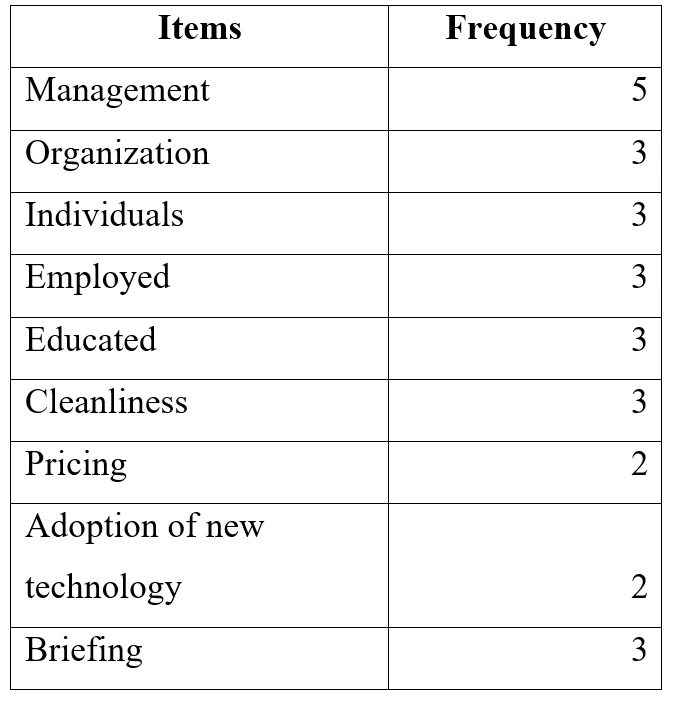
Benefits because of Total Quality Management
Respondents were questioned about the experienced of any benefits because of Total Quality Management. The findings showed that the organization became more efficient, loyal and moral, and it shows with the following excerpts, "It has helped the organization become more efficient. It helps in building better goodwill. It helps the organization review its performance and progress (Resp 1, 7). Some felt that by TQM, there is an increase in the loyalty, morale, and productivity of employees (Resp 2) and experienced benefit of satisfaction of kids and elders (Resp 2, 3, 8). There have been a lot of benefits, but they can only be measured in quantitative and qualitative terms (Resp 4,9) about something tangible, but most of them thought it was not suitable for the concept of TQM (Resp 5). It helped improve the quality of work, paved the way for the advent of new activities and policies (Resp 6), and helped maintain quality to a great extent. But some have experienced so many benefits to adopting TQM (Resp 10) and made our customer know about the importance of quality, spread the awareness about that and gain the maximum value."
Table 4.8 Frequency of Benefits because of Total Quality Management
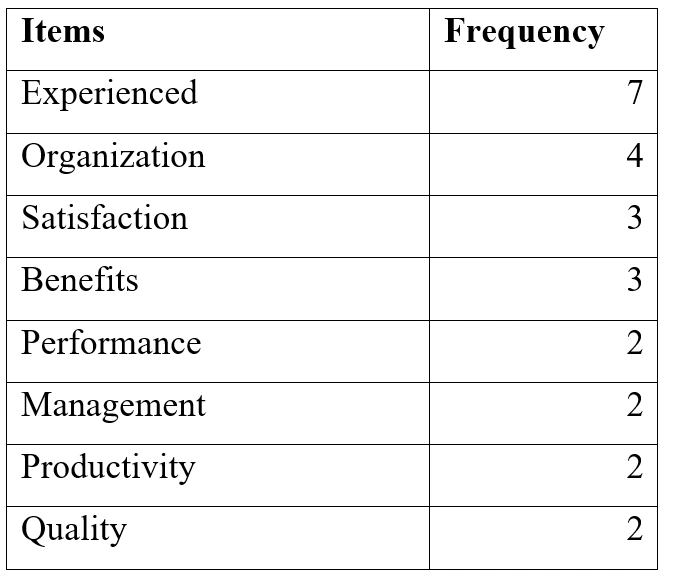
Organization for continuous improvement
Respondents were questioned about what they want to do for the organization's continuous improvement. The findings showed improvement and encouragement, as shown in the following excerpts: "They facilitate and cater to training for regular teachers, persons with disabilities, parents, and volunteers (Resp 1), and it provides results at every stage of operations performed. For continuous improvement, our organization accepts more donations and sponsors, even from foreign countries, to make everything more convenient for the people in the NGO (Resp 2,8). They encourage employees through rewards and come up with competent activities (Resp 3). Continual improvement drives an organization to be analytical and creative in finding ways to become more competitive and more effective at meeting take holder expectations. So, before launching any product, we distribute it among employees to seek their opinion and identify any issues and changes required in terms of look, user-friendliness, etc. (Resp 4, 9, 10). Apart from this, we also took the customer feedback, tried to resolve their issues, and identified any points we needed to consider in making the next product to satisfy the customer's needs (Resp 5,7). Suppose any accountabilities get identify after launching of product (Resp 6). In that case, we recall all the products from the market, resolve those issues and provide the existing customer updated product with a complimentary gift as a gratitude for their troublesome."
Table 4.9 Frequency for Organization for continuous improvement
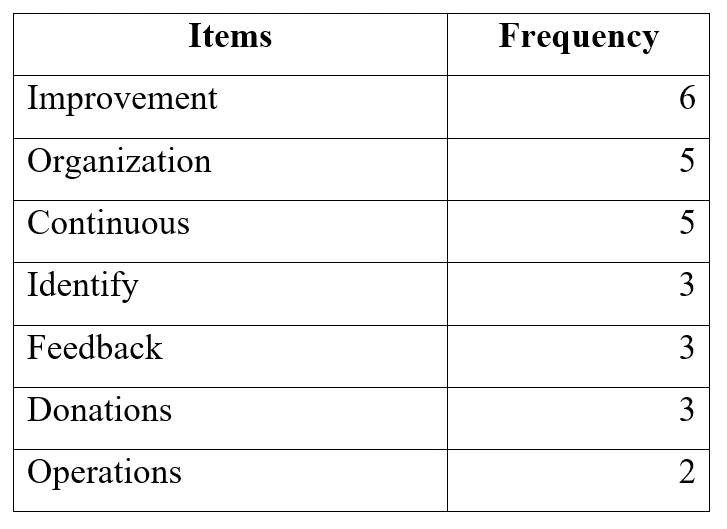
Summary
This overall analysis discusses the Total Quality Management (TQM) in Non-Governmental Organizations (NGOs) In India. Even though they faced many issues, they still worked on improving the quality of the work.
Related Services
Our academic writing and marking services can help you!
Study Resources
Free resources to assist you with your university studies!
